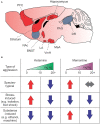Promises and Pitfalls of NMDA Receptor Antagonists in Treating Violent Aggression
- PMID: 35801096
- PMCID: PMC9253591
- DOI: 10.3389/fnbeh.2022.938044
Promises and Pitfalls of NMDA Receptor Antagonists in Treating Violent Aggression
Abstract
Treatment options for chronically aggressive individuals remain limited despite recent medical advances. Traditional pharmacological agents used to treat aggression, such as atypical antipsychotics, have limited efficacy and are often replete with dangerous side effects. The non-competitive NMDAR antagonists ketamine and memantine are promising alternatives, but their effects appear to be highly dependent on dosage, context, and personal experience. Importantly, these drugs can increase aggression when combined with substances of abuse or during periods of heightened stress. This is likely due to mechanistic differences operating at specific synapses under different contexts. Previous findings from our lab and others have shown that early life stress, substance abuse, and attack experience promote aggression through NMDAR-dependent synaptic plasticity within aggression-related brain circuits. Ketamine and memantine affect these types of aggression in opposite ways. This has led us to propose that ketamine and memantine oppositely affect aggression brought on by early life stress, substance abuse, or attack experience through opposite effects on NMDAR-dependent synaptic plasticity. This would account for the persistent effects of these drugs on aggression and suggest they could be leveraged as a more long-lasting treatment option. However, a more thorough examination of the effects of ketamine and memantine on cellular and synaptic function will be necessary for responsible administration. Additionally, because the effects of ketamine and memantine are highly dependent on prior drug use, traumatic stress, or a history of aggressive behavior, we propose a more thorough medical evaluation and psychiatric assessment will be necessary to avoid possible adverse interactions with these drugs.
Keywords: NMDA receptor; aggression; early life stress; ketamine; medial amygdala; memantine; synaptic plasticity.
Copyright © 2022 Bartsch and Nordman.
Conflict of interest statement
The authors declare that the research was conducted in the absence of any commercial or financial relationships that could be construed as a potential conflict of interest.
Figures

Similar articles
-
Opposing effects of NMDA receptor antagonists on early life stress-induced aggression in mice.Aggress Behav. 2022 May;48(3):365-373. doi: 10.1002/ab.22022. Epub 2022 Feb 4. Aggress Behav. 2022. PMID: 35122262 Free PMC article.
-
Potentiation of Divergent Medial Amygdala Pathways Drives Experience-Dependent Aggression Escalation.J Neurosci. 2020 Jun 17;40(25):4858-4880. doi: 10.1523/JNEUROSCI.0370-20.2020. Epub 2020 May 18. J Neurosci. 2020. PMID: 32424020 Free PMC article.
-
Memantine and Ketamine Differentially Alter NMDA Receptor Desensitization.J Neurosci. 2017 Oct 4;37(40):9686-9704. doi: 10.1523/JNEUROSCI.1173-17.2017. Epub 2017 Sep 6. J Neurosci. 2017. PMID: 28877967 Free PMC article.
-
Anger management: Mechanisms of glutamate receptor-mediated synaptic plasticity underlying animal aggression.Int J Biochem Cell Biol. 2022 Jan;142:106120. doi: 10.1016/j.biocel.2021.106120. Epub 2021 Nov 23. Int J Biochem Cell Biol. 2022. PMID: 34823006 Free PMC article. Review.
-
Recent insights into the mode of action of memantine and ketamine.Curr Opin Pharmacol. 2015 Feb;20:54-63. doi: 10.1016/j.coph.2014.11.006. Epub 2014 Dec 2. Curr Opin Pharmacol. 2015. PMID: 25462293 Free PMC article. Review.
Cited by
-
Acute social defeat during adolescence promotes long-lasting aggression through activation of the medial amygdala.Front Neurosci. 2024 Jul 10;18:1433993. doi: 10.3389/fnins.2024.1433993. eCollection 2024. Front Neurosci. 2024. PMID: 39050664 Free PMC article.
-
A single dose of ketamine enhances early life stress-induced aggression with no effect on fear memory, anxiety-like behavior, or depression-like behavior in mice.Behav Neurosci. 2023 Oct;137(5):281-288. doi: 10.1037/bne0000560. Epub 2023 Jun 15. Behav Neurosci. 2023. PMID: 37326523 Free PMC article.
-
Visualizing traumatic stress-induced structural plasticity in a medial amygdala pathway using mGRASP.Front Mol Neurosci. 2023 Nov 30;16:1313635. doi: 10.3389/fnmol.2023.1313635. eCollection 2023. Front Mol Neurosci. 2023. PMID: 38098941 Free PMC article.
References
LinkOut - more resources
Full Text Sources
Miscellaneous

